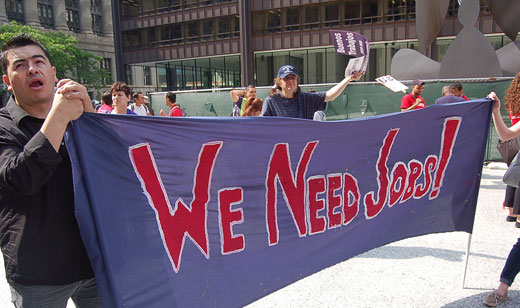
WASHINGTON – The nation’s jobless rate dropped 0.1 percent in February, to 7.7 percent, the Bureau of Labor Statistics reported. Businesses claimed to create 236,000 new jobs that month, a separate survey showed.
The number of unemployed declined by 300,000, to 12.03 million, but the number of people not counted in the workforce rose by 296,000, to 89.3 million. And that wasn’t the only warning signal in the data.
Some 40.2 percent of the jobless in February have been out of work for longer than six months, an increase of 2.1 percent in one month. That means those long-term jobless have exhausted their state benefits and rely on federal benefits – if they’re there.
And 14.3 percent of all workers – one of every seven – are “underutilized.” They’re jobless, discouraged and have dropped out or work part-time even though they want full-time jobs. That figure is down only 0.1 percent from the month before.
Pro-worker economists noted the rise in labor-force dropouts.
“The strong showing is welcome, but given the deficit of 8.9 million jobs, even at February’s growth rate we wouldn’t get back to the pre-recession unemployment rate (five percent) until 2017,” said Heidi Shierholz of the Economic Policy Institute. The jobless rate drop “was not due to a larger share of the working-age population landing jobs, however, as labor force participation slipped back to its lowest point of the downturn.
“All in all, this was a strong report, but we need reports this strong and stronger for several years to get back to health in the labor market,” she concluded. Dean Baker of the Center for Economic Policy and Research agreed and added another warning: “There is the risk” the decline “is being driven by unusually good winter weather.”
Factories added 14,000 jobs, rising to 11.977 million. Most were in wood products (+4,000), fabricated metal plants (+6,400) and food producers (+3,400). There were 1.108 million jobless factory workers, with a 7.2 percent jobless rate.
Construction added 48,000 jobs, to 5.784 million. Three-fourths of those jobs (31,700) were with specialty trade contractors. And CEPR’s Baker said construction gained jobs due to the unusually warm winter. But there were still 1.291 million jobless construction workers, or 15.7 percent, BLS reported.
Construction union leaders say the data underreport unemployment in their industry, since a worker employed even one day during the BLS survey week is counted as holding a job for the whole month. The leaders say the real jobless rate in their industry is closer to 25 percent.
Services claimed to add 179,000 jobs. Biggest gains were in retail trade (+23,700), motion pictures (+20,800), temps (+16,000), health care (+32,000) and bars and restaurants (+18,700). Those, except the movies, are among the lowest-paying sectors.
Governments shed 10,000 jobs, with the states (-8,000) doing the dumping. The federal government lost 4,500 workers but the Postal Service – whose boss wants to fire 100,000 workers and cut another 100,000 by attrition – added 4,200, to 607,600.
Photo: Jobs demonstration in Chicago PW










